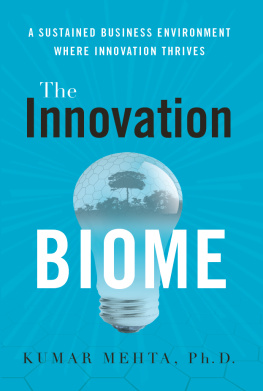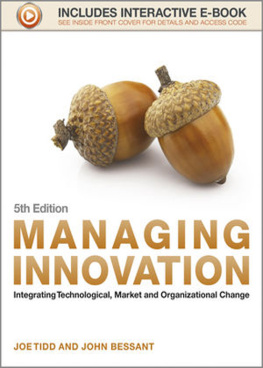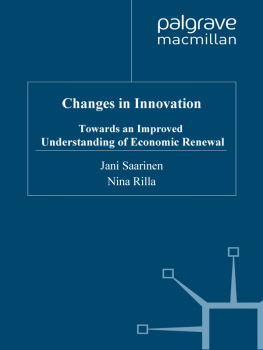MANAGING GLOBAL INNOVATION
FRAMEWORKS for INTEGRATING CAPABILITIES AROUND the WORLD
YVES L. DOZ KEELEY WILSON
HARVARD BUSINESS REVIEW PRESS
Boston, Massachusetts
Copyright 2012 Harvard Business School Publishing Corporation
All rights reserved
Printed in the United States of America
10 9 8 7 6 5 4 3 2 1
No part of this publication may be reproduced, stored in or introduced into a retrieval system, or transmitted, in any form, or by any means (electronic, mechanical, photocopying, recording, or otherwise), without the prior permission of the publisher. Requests for permission should be directed to , or mailed to Permissions, Harvard Business School Publishing, 60 Harvard Way, Boston, Massachusetts 02163.
Library of Congress Cataloging-in-Publication Data
Doz, Yves L.
Managing global innovation : frameworks for integrating capabilities around the world / Yves L. Doz, Keeley Wilson.
p. cm.
ISBN 978-1-4221-2589-2 (alk. paper)
1. Technological innovationsManagement. 2. Diffusion of innovationsManagement. 3. International business enterprisesManagement. I. Wilson, Keeley. II. Title.
HD45.D679 2012
658.4063dc23
2012012904
TABLE OF SIDEBARS
Chapter 1
Chapter 2
Chapter 3
Chapter 5
Chapter 6
Chapter 7
In Memoriam
To Gunnar, Sumantra, and C. K.
They paved our way.
FOREWORD
This book explains how to conceive, build, and hone a global innovation capability that is enduring, practical, and rooted in the realities of both global competition and a companys particular approach to its market. Yves Doz and Keeley Wilson have brought their considerable expertise to bear on a subject of fundamental strategic importance, both rich in promise and perilous in its potential for misinterpretation and misapplication. Innovation has become such an all-encompassing concept and powerful driver of modern business strategy that company leaders lose focus when asked to define innovation and how they intend to achieve it. Globalization only adds to the challenge.
Along come Doz and Wilson with a blueprint for organizing, building, and managing a global innovation capability, from design through execution. And they offer seasoned counsel on how to tailor this blueprint to the parameters of a particular industry and the priorities of a given company.
Just as we do at Booz & Company, the authors start with focus. It is our shared belief that companies create long-term competitive advantage by recognizing, developing, and continuously improving a limited set of interrelated winning capabilities. Assets and market positions are transient. In contrast, core capabilities are sustainable and defensible in the long term. In the new world context of open market access and dispersed knowledge, managing global innovation will become an integral component in many companies systems for growing winning capabilities. To continuously create and capture value, companies must not only know how to design and develop a valuable and flexible innovation footprint, but also learn to integrate worldwide knowledge and experience through effective processes and systems driven by strong leadership.
The notion that Doz and Wilson are onto something is not news to usBooz & Company has worked with both authors for almost a decade, developing insights on innovation and how it has taken shape around the world, market by market. In 2004 we undertook a study of global innovation networks with INSEAD that provided a preview of some of the trends explored in this book, and we have continued to participate in their work on innovation regimes and global innovation in specific industries, such as telecom and pharmaceuticals.
Looking back just a few years, it is remarkable how rapidly our early findings have taken hold and become key issues for companies around the world, both in developed and developing economies. Our early study focused on companies from developed economies that were expanding their innovation footprints into China and India. In fact, that is where most of their incremental R&D investment was going. Now, were observing a turn in the tide, as companies in China and India are investing their R&D and innovation currency in the United States, Europe, and even Japan. Indias Tata Motors acquired not only brand equity, but also technology and a European automotive R&D footprint by acquiring Jaguar and Land Rover. Chinas SANY Group has opened R&D centers in Germany and the United States. Huawei Technologies has an extensive global R&D footprint and a $4.5 billion global R&D budget.
All of these companies now face the challenge of managing innovation on a truly global basisidentifying, accessing, stimulating, and integrating the best ideas and capabilities from around the world into innovations that will serve world markets while at the same time pioneering new ways of collaborating both inside and outside company walls. Its a daunting challenge, and few companies have found a winning formula.
Senior leaders need practical suggestions to find the proper architecture for implementing global innovation networks and meeting the day-to-day challenges of crossing borders in the development of ideas into products and services. This book is for corporate leaders but also for frontline innovators, and not only in developed economies, but also in China, India, Brazil, Indonesia, and other developing economies now spreading their wings on the global stage. It combines an understanding of the fundamental drivers of success in managing global innovation with practical strategies for building a productive and enduring innovation capability. It describes a long journey that requires a set of guiding concepts and principles, as well as an architecture of systems and processes. Doz and Wilson provide both in this expert road map for building the capability to manage global innovation.
Cesare Mainardi
Chief Executive Officer
Booz & Company
PREFACE
In an essay arguing for a shift toward a more globally distributed and integrated approach to innovation, Sam Palmisano, the highly regarded chairman (and recently retired CEO) of IBM, cautioned, As the twin imperatives of [global] integration and innovation render the old MNCs networks of national hubs inefficient and even redundant, it is becoming increasingly clear that the twentieth-century corporate model is no longer optimal for innovation. Similarly, at GE, Jeff Immelt has put the globalization of innovation at the center of his strategic agenda. During Henning Kagermanns tenure as CEO of SAP, when asked by one of the authors what he considered his companys most difficult strategic challenges, he answered, To build a global innovation network. Along with many other managers, these executives have all recognized that over the past decade, there has been a growing need for radical change in the way their firms innovate.
As with any radical and systemic change, embracing global innovation will be difficult. It requires new structures, processes, tools, capabilities, and perhaps most important, new mind-sets. Our goal in writing this book, which is the result of more than a decade of research, is to give executives and managers from companiesboth large and small, established and newa guide to achieving that change and repositioning their companies to compete in the era of global innovation.
To explain the origins of this book requires us to go back to 2001, when Yves Doz and two colleagues at INSEAD, Jose Santos and Peter Williamson, published From Global to Metanational. This was a manifesto for highly dispersed innovation, based on a few pioneering firms that were tapping the world for new knowledge. Although From Global to Metanational described what this new form of innovation looked like, it didnt explain how firms could build the structures, mechanisms, and processes needed to undertake dispersed innovation.
Next page








